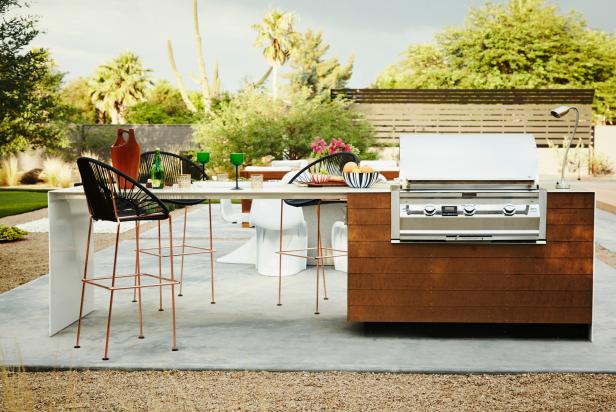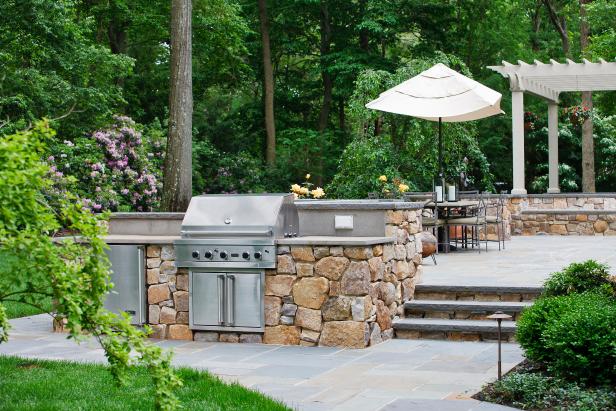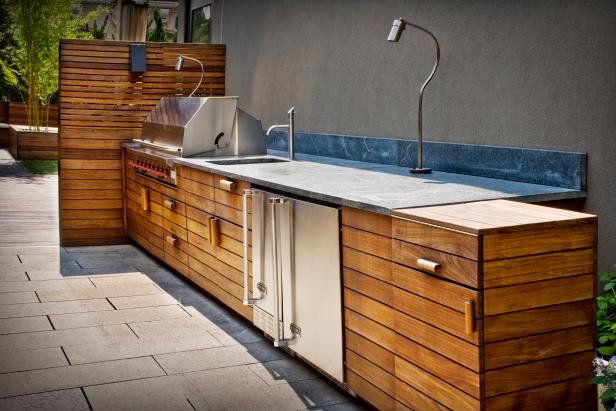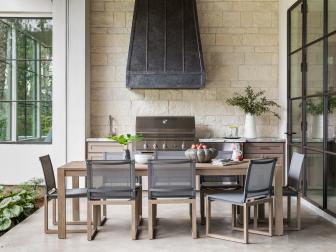Creating a complete outdoor cooking space can be expensive, but you can still put together a great outdoor kitchen without spending a fortune. Learn how to find a balance between what you want and what you can afford.
You can spend anything you want on an outdoor kitchen, from $500 for a freestanding grill with a rolling side cart to $50,000 for a fully outfitted cooking and entertaining zone with built-in, high-end appliances, stone countertops and plenty of room for guests. Most people will find the perfect fit someplace between these two extremes. Here are a few things to keep in mind as you decide how much you should spend on your outdoor kitchen.

Consider Your ROI, Climate + Neighborhood
An outdoor kitchen is your money well spent. The return on investment (ROI) for building an outdoor kitchen is from 55% to 200% depending on your location and comparable homes in the area. So, you need to do a little research to find out where on that scale your ROI will be.
How often will my outdoor kitchen get used? In a cold climate, you may only use the outdoor kitchen for two or three months of the year. If you live in Southern California, the outdoor kitchen may be a year-round extension of your home. How much you should invest in the project should be proportionate to how much you’ll use the space.
What are the neighbors doing? If you want to get a reasonably good return on your investment at resale, don’t improve far beyond the level of the neighborhood. In other words, your backyard shouldn’t be the only or the most expensive outdoor kitchen on the block.
Did you factor in the tax increase? If you must file building permits, your property will likely be reassessed for the value of the project, and your property taxes may increase accordingly.

Determine Wants vs. Needs
Sure, a super-sized grill with infrared searing zones, dual fuel, a rotisserie and a side burner looks awesome in the showroom, but if all you ever grill are burgers and hot dogs for your family of four, you’ll be spending a bundle on features you don’t need.
Make a list of must-haves and not-necessary items then determine if you need them right away or if they can wait until next season or the one after that. By prioritizing and deferring some of the features, you may be able to get your dream kitchen even if it’s not all at once.
Explore beautiful outdoor kitchen design ideas for inspiration for your own backyard cooking space.
You may find picking out cabinets and countertops mind-boggling because there are so many choices when it comes to the types of materials. Style and budget may be your top concern, but durability should also be a key issue. You want to invest your hard-earned dollars in materials that will stand up to the elements and last a long time. Your climate will be your first consideration — hard winters and intense summers will limit your cabinet and countertop substrates. Also, your climate may dictate how much long-term maintenance you’ll need to give your cabinets and countertops. Will your outdoor kitchen be exposed to the elements or is it under a covered patio? Direct sunlight can fade colored surfaces, while pelting rain and inches of snow sitting on the surface will wear down materials far quicker than those in a kitchen under a covered patio.
A Long-Term Plan Helps Sticking to the Budget
Build in phases. Your budget may not allow you to get your dream kitchen all at once, especially if you’re DIYing some of it. Start with your foundation and utilities. “Customers on a strict budget typically concentrate on getting the deck or arbor built first,” says Kooda Exterior’s Burt Stavinoha. “But even if you can’t afford anything else right away, have the forethought to beef up the flooring slab where you might later put an island, or pour the foundation for a future fireplace when you pour the concrete [footings] for the deck.”

Decide what is necessary and what can be deferred until next year. Cabinets with solid surface countertops and built-in appliances are most often a must-have item, but if your budget is tight, put them off until next season. Implement rolling carts, portable tables and large coolers instead — there are many ways you can make these items look festive and fun for any occasion. Start your spending on the star of any outdoor kitchen, the grill. You can still make memorable meals on a quality grill no matter what else you have around it. Grills on rolling carts are a nice way to plan for an upgrade later, says Mike Logan of Texas Pit Crafters. “Most grills and smokers can be installed on a rolling cart with an adequate number of side trays and some storage beneath and then removed later and reinstalled into a pit if your budget increases,” he says. “The cart’s a great idea if you want the feel of an outdoor kitchen on a tight budget.”
Plan ahead for utilities. Running utility lines — gas, electricity and water — to your outdoor kitchen can eat up a large chunk of your budget. If you’re thinking of waiting on installing those utility lines, keep in mind that adding them down the road might cost more if you have to rip up patios, decks or walls. If you plan on being in the house a long time and know it’s worth the investment, start with the utilities then defer the other high-dollar features for a while. If you’re not planning on staying in the house long term, weigh the cost of the investment; having outdoor utilities in place may boost your home’s resale value. Talk to some local real estate agents to find out what sells in your area.

How to Plan and Build an Outdoor Kitchen
Aesthetics are important but when it comes to building an outdoor kitchen, functionality and durability reign supreme. Read our professional tips to budget, plan and design an outdoor kitchen that will add value to your home and lifestyle.
Another plan-ahead item is lighting. You don’t want to get your outdoor dream kitchen built only to realize you forgot to put overhead lighting in the dining area or task lighting in the grilling area. When planning for your utilities make sure you’ve got electrical lines running to each outdoor living area. Also, be sure to include electricity for outdoor fans and heaters as well as lighting on pathways and staircases that lead to your outdoor areas.
Where to Splurge vs. Save
Splurge: Buy a hardy grill. It’s counterintuitive, but you have a better chance of sticking to a budget if you sink money into a high-quality grill. “I can’t tell you how many times customers end up calling us back a year later to replace a low-quality grill,” says Burt of Kooda Exteriors. “They’re going to burn out on you.” Mike of Texas Pit Crafters strongly recommends a grill made from high-grade stainless steel. “Look for a model made from at least 304-grade stainless steel, interior and exterior, because if the inside rusts out there’s nothing you can do to save the rest,” he says.
Save: Pick propane. If running gas lines is out of the question, propane is not a bad option. “Running gas lines, electricity and water to an outdoor island is fairly expensive,” says Mike. “If you’re on a tight budget, you might want to consider using propane bottles to fuel your grill.”
Save: Forget the sink. Building codes and plumbing costs can make a sink one of the most expensive outdoor kitchen propositions. If a sink is a must for your outdoor kitchen, consider installing an under-counter water heater instead of plumbing a hot water line from the house. They cost about $300, but you will need to have gas or propane run to the unit.
Splurge: Opt for a real outdoor fridge. An outdoor refrigerator can cost anywhere from $400 to $2,500. And no, you can’t just use any old mini fridge. The exterior of outdoor refrigerators is made from weatherproof and anti-rust materials that can function in extreme temperature ranges and in high humidity. There is more insulation in an outdoor fridge to help maintain its internal temperature, and it’s equipped with a heavy-duty compressor to also maintain that desired temperature. A typical indoor fridge may only see an external temperature fluctuation of 15 to 20 degrees, so it’s not built to withstand hot, humid summers and brutal winters. If you can’t swing the cost of the fridge this year, coolers, large ice buckets and kiddie pools can keep a lot of beverages cool and look great doing it.
Go for more practical options. Yes, a large, brick, wood-burning pizza oven would be amazing, but it’s going to cost a pretty penny and you’ll always need to make sure you have plenty of firewood on hand, and plan ahead to make sure the oven is hot enough when you’re ready to cook. To save money and time, consider a countertop model or one that fits inside of your gas grill.
Don’t skip the permits. And don’t rule out using a general contractor. Research your local building codes and get a permit if needed. Permits average about $500. You’ll also need to have your city or town building inspector or structural engineer inspect your outdoor kitchen and sign off that it is compliant with local building codes — this is known as a certificate of occupancy. Don’t skip the permits or certificate of occupancy; not having these can come back to haunt you if you have an insurance claim or when you sell the home.
You may think hiring a general contractor will cost more, but it may actually help you save. A contractor will make sure you have licensed sub-contractors — plumbers, electricians, landscapers — who work on your project. They’ll also know the correct order and timing for each aspect of the project. A good contractor will be able to pull the permits for you and take care of any needed inspections.








